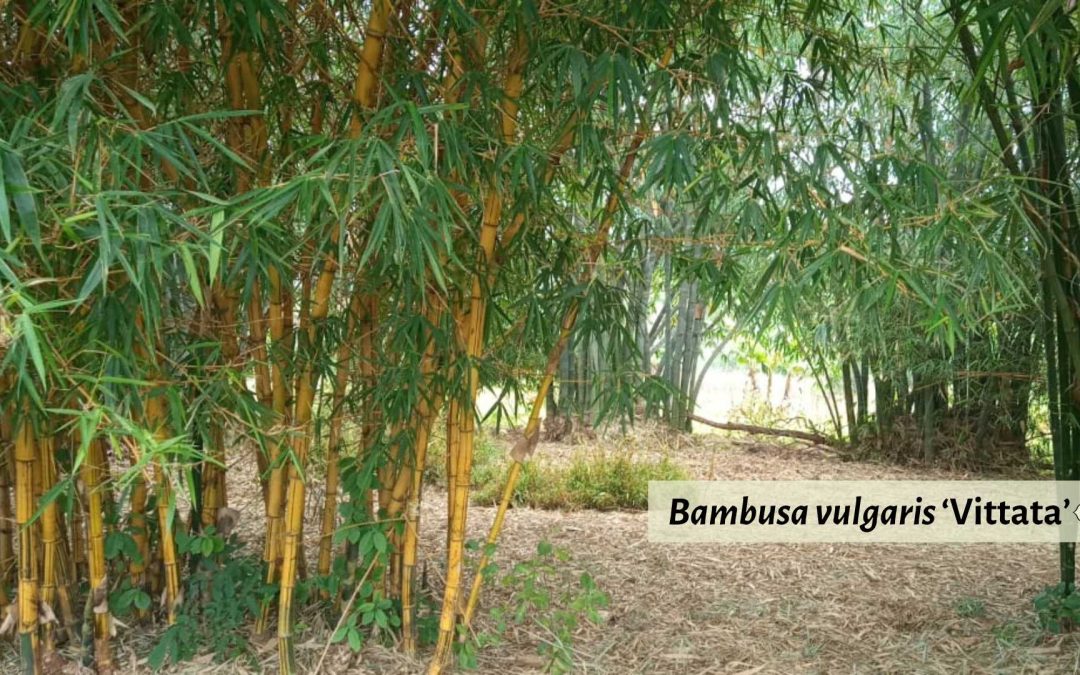Accurately identifying a bamboo species can be one of the greater challenges in the field of botany or gardening. Most anyone can recognize bamboo when they see it, but not everyone realizes how many species there are to choose from. (Around 1,500.) And when you ask about the species, you might only be told that it’s just “regular bamboo” or “common bamboo” or “yellow bamboo”. That’s not super helpful, but if you’re wandering through a tropical forest in southern Mexico, or Ghana, or Malaysia, then there’s a good chance you’re looking at Bambusa vulgaris.
Bambusa vulgaris, is an especially widespread species of bamboo, probably native to Southern China, but now naturalized in tropical climates throughout the globe. The name literally translates to “common bamboo,” which is appropriate considering its extensive distribution from Asia to sub-Saharan Africa to Latin America. This timber species can grow 50 or 60 feet tall in the best condition, with culms 3 to 4 inches thick. The poles are strong and useful for a variety of applications.
This article is part of an ongoing series about different species and cultivars of bamboo. To learn more, check out some of these other detailed articles.
- BAMBOO SPECIES GUIDE
- A gallery of bamboo species
- Bambusa oldhamii: The most popular bamboo of all
- Black Bamboo: Phyllostachys nigra and others
- Blue Bamboo: Species that stand out
- Buddha’s Belly Bamboo
- Chimonobambusa quadrangularis: Square Bamboo
- Dendrocalamus asper: Giant Dragon Bamboo
- Golden Bamboo: Phyllostachys aurea and others
- Semiarundinaria Fastuosa: Temple Bamboo
Origins and distribution of Bambusa vulgaris
This variety of bamboo is now so widely distributed that it’s hard to be sure where exactly it came from. But most authors speculate that B. vulgaris probably originate in Southern China and gradually spread outward. While Moso, Phyllostachys edulis, is far more common and utilized in the north, where winters are cold and snowy, Bambusa is a sub-tropical genus whose members are not so cold-hardy.
From its native habitat, B. vulgaris has been unusually successful in spreading. You can find this bamboo species throughout Southeast Asia, the Pacific Islands, Africa, and Latin America. In other words, it flourishes in tropical zones around the world.
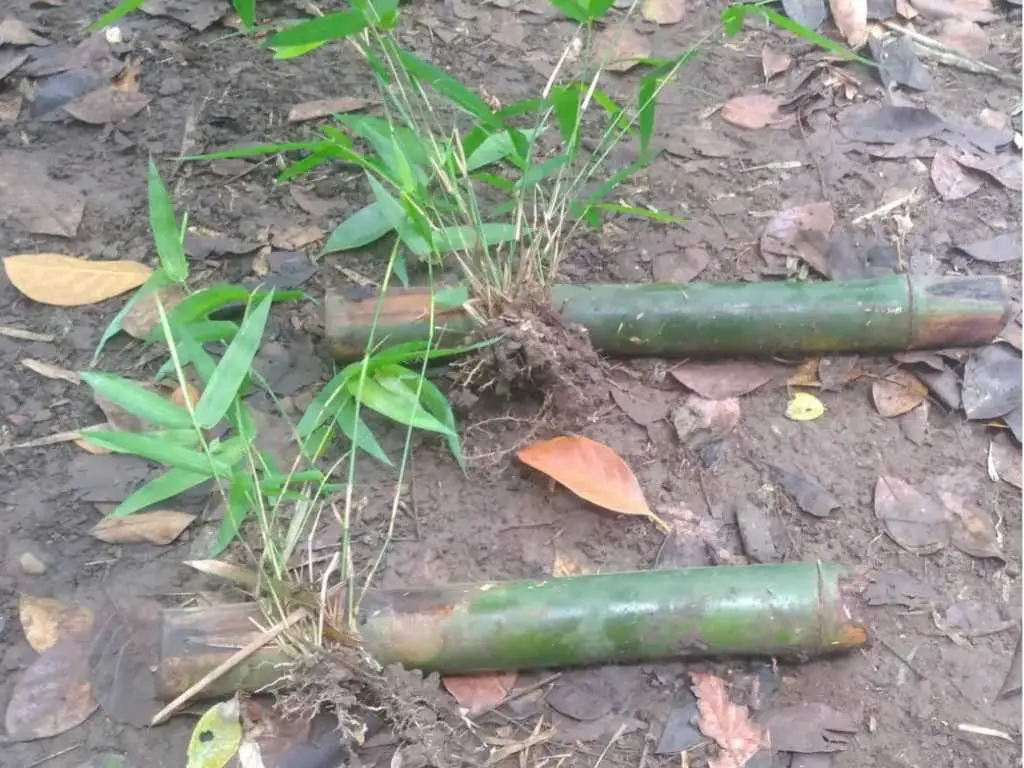
Over time and across distances, the species has diversified. Authors now recognize three groups of B. vulgaris, namely green, yellow and bulbous. (See the section below on Varieties and Subspecies.) Despite their distinct characteristics, these all still belong to the same species.
How this species has managed to spread so far and wide remains a bit of a mystery. One theory is that British sailors and botanists collected it in southern China in the 18th century and proceeded to carry it around the world. The size, strength and resistance of the plant earned it great acceptance, and farmers were eager to plant it wherever they could to produce a quick and abundant building material. It’s also a tenacious species that is quick to take root when cuttings are left on the ground. That’s why the sun never sets on the Bambusa empire!
Characteristics of Bambusa vulgaris, or Common Bamboo
Bambusa is a very diverse genus of bamboo, with about 150 species. As the name suggests, Bambusa is a common and important genus. The numerous species can come in a wide variety of shapes, sizes and colors, but B. vulgaris is definitely a timber species, commonly growing more than 50 feet tall.
As a subtropical genus, all species of Bambusa are clumpers. This makes them less prone to spread out and take over. As a general rule, most gardeners much prefer this growth habit, as it’s far more manageable. Compared to other tropical bamboo, however, B. vulgaris is more of an open clumper, so the clumps tend to stretch a bit wider than others like B. textilis or B. oldhamii.
Bambusa species are somewhat more cold-tolerant than other tropical genera like Dendrocalamus and Gigantochloa, but they are still not suitable for regions with severe winters. You’ll have the best success with this species in places like Florida or Southern California, but you can do even better with a variety like Oldhamii. Prolonged temperatures below about 30º will likely result in frost damage. It also requires generous amounts of water.
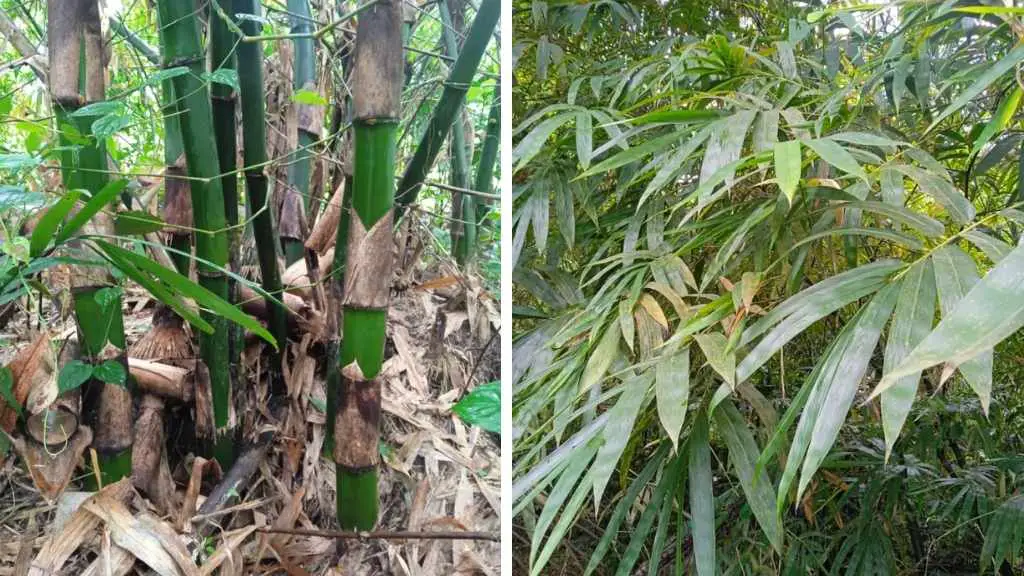
Based on its botanical name (or binomial nomenclature), we know that Bambusa vulgaris must be one of the most common types of bamboo. You can find it growing all over Southeast Asia and China and it is fairly easy to recognize. It is one of the more towering species of bamboo, often reaching more than 50 or 60 feet in height, with dark green culms 3 to 5 inches in diameter. It has an open clumping habit, so it can spread relatively quickly, even though it’s not a runner.
In its native regions, this species of bamboo is very important for its giant culms which are widely used for rudimentary building and construction, including houses, scaffolding, and fencing. Higher levels of lignin and cellulose also make this a desirable bamboo for paper pulp. The shoots can be eaten, but they are not considered to be very tasty, compared to species like Asper and Moso. The higher-than-average levels of cyanic glycosides produce a somewhat bitter flavor.
Flowering is rare with this species. Research on B. vulgaris indicates a flowering period of about 80 years, although evidence is still scarce. Flowering does not seem to generate any seeds. But that’s not a problem, because this bamboo is very easy to propagate from stem cuttings. There’s at least one commercial nursery in Nigeria that’s reproducing this species on a fairly large scale. But it really requires little or no encouragement for these cuttings to proliferate. That’s why this species is so common.
Uses for B. vulgaris
This species of bamboo, so common is widespread, is often thought of as a weed by bamboo connoisseurs. Indeed, there are many better species to cultivate for building material or construction purposes. But we shouldn’t underestimate the potential of this prevalent bamboo.
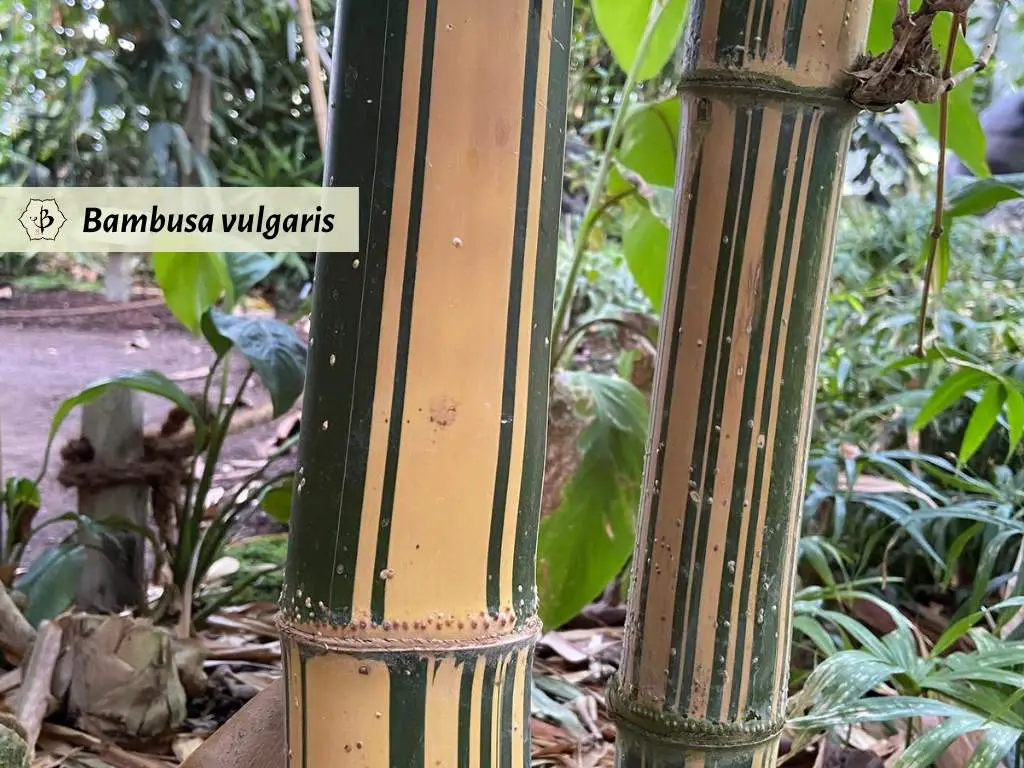
In wetter conditions, B. vulgaris grows quickly and vigorously. As a result, the cell structure is loose and spread out. In other words, the wood is not very hard. That means there may not be so much structural strength, but it is good for reducing into pulp for paper.
In drier conditions, like other bamboo varieties, vulgaris tends to grow much denser. The fibers are harder and woodier, making it more reliable for building durable structures. However, the culms have a slight zig-zag, making them less optimal for construction, compared to the perfectly straight poles of Dendrocalamus asper.
Varieties and subspecies of Bambusa vulgaris
As it spread and colonized the world, likely with the help of the colonial aspirations of the British empire, Bambusa vulgaris has diverged into an array of subspecies. Most easily, we can divide them into green and golden groups.
The picture directly above, from West Africa, shows the common green bamboo. The image at the top of the article shows a golden specimen. The golden strains of this species are typically classified as Bambusa vulgaris var. striata. There are common in Southern Mexico and Central America. Generally, they tend to have thicker walls and better-quality wood.
B. vulgaris ‘Vittata’ is a popular ornamental cultivar of this species, pictured below. Unlike the original species, this subspecies has buttery yellow poles. The distinctive culms stripes, which are each unique, have earned it the nickname “Painted Bamboo.” This species seems slightly more cold-hardy than the original, which also contributes to its popularity among gardeners in the US. Still, it does require a pretty mild climate, like that of California and the southern states, and regular irrigation.
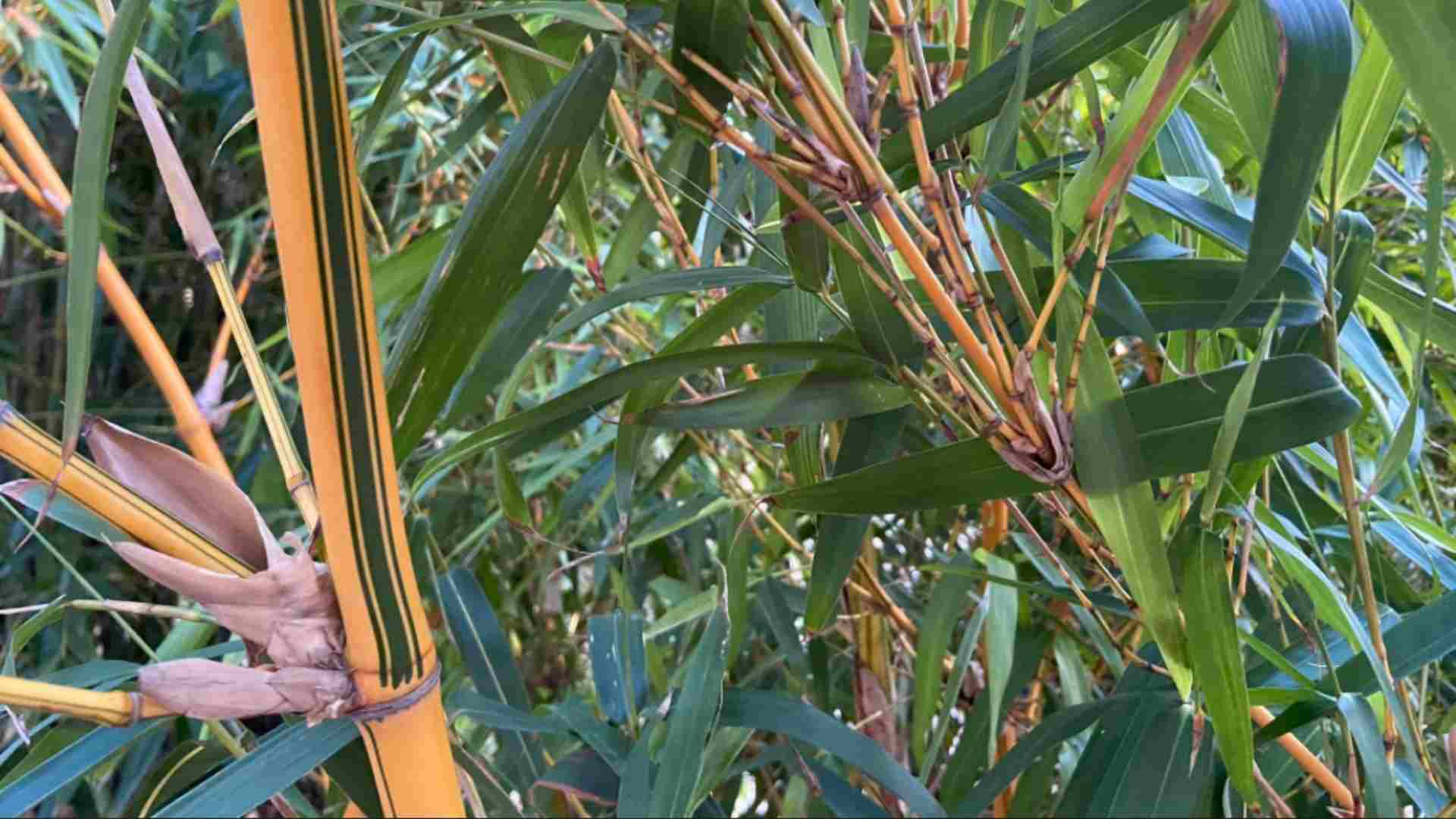
Bambusa vulgaris var. wamin is another popular strain, better known as Buddha Belly Bamboo. It has bulbous internodes that bear a certain resemblance to a cheerful, bulging belly.
Learn more about bamboo
If you enjoyed this article about common bamboo varieties, please consider sharing the blog post or subscribing to our mailing list. You might also be interested in some of the following links:
- Best cold-hardy bamboos for snowy climates
- Bamboo for hedges and screens
- Best bamboo varieties for poles
- Best bamboo for construction
- Growing bamboo in pots
- Growing bamboo indoors
- Bamboo containment
FEATURE PHOTO: Bambusa vulgaris ‘Vittata’, also called Golden Bamboo or Common Bamboo, on a farm in Kenya.

